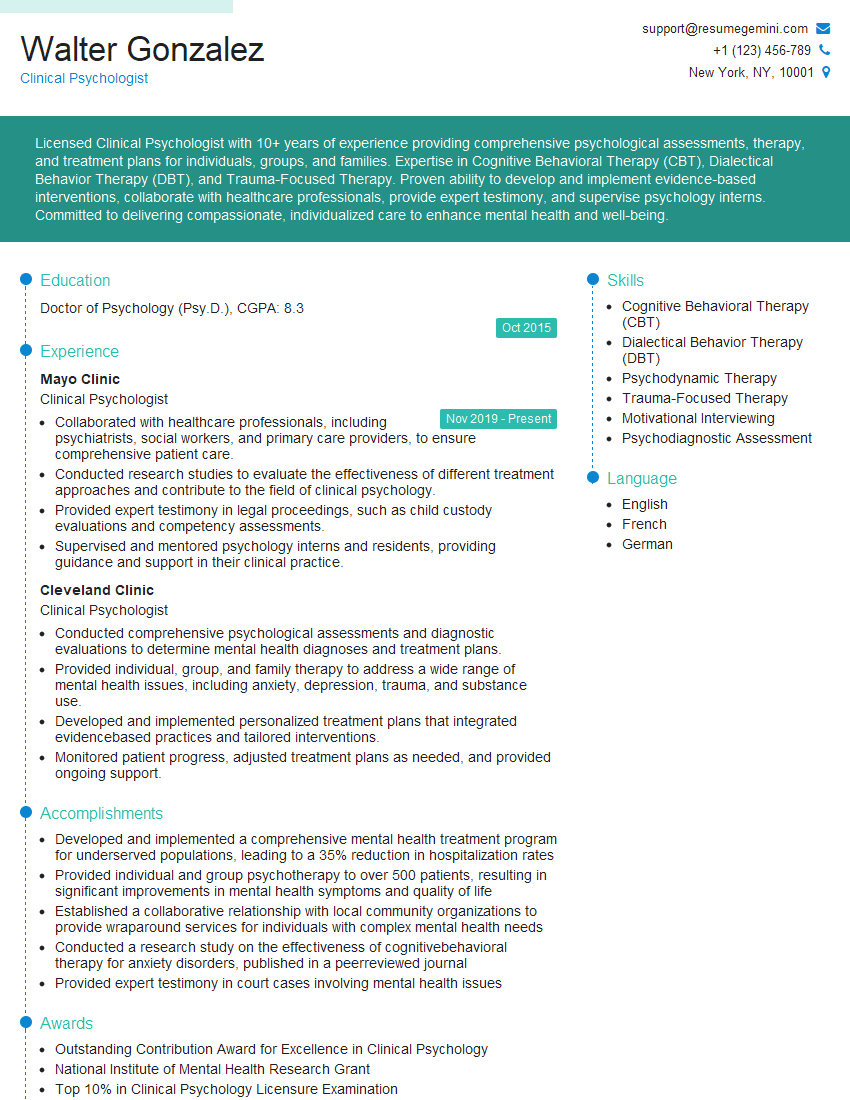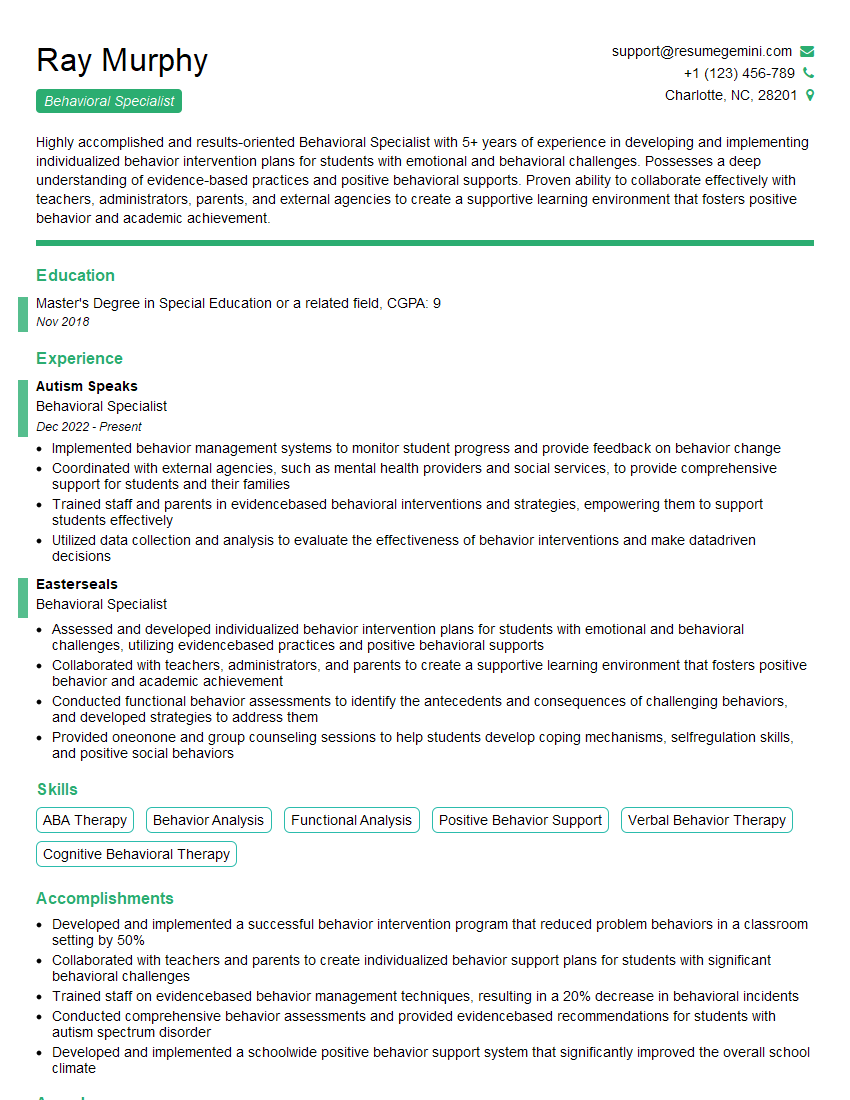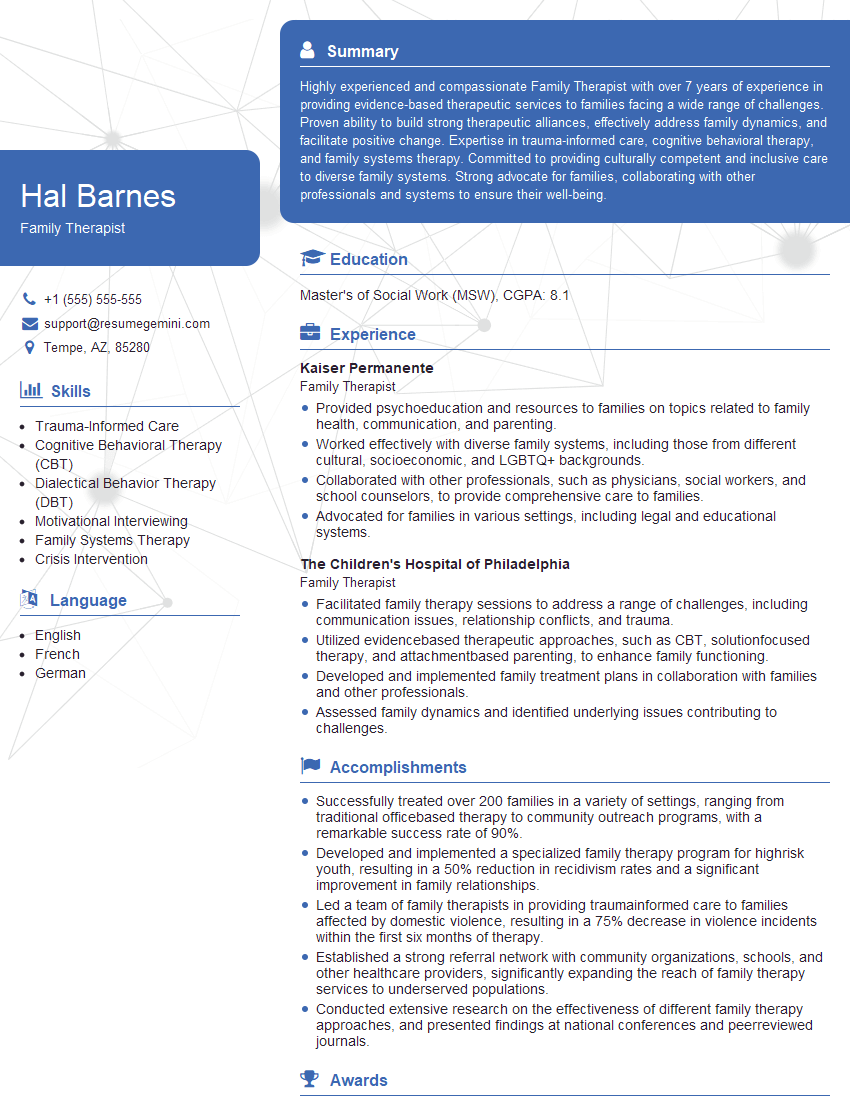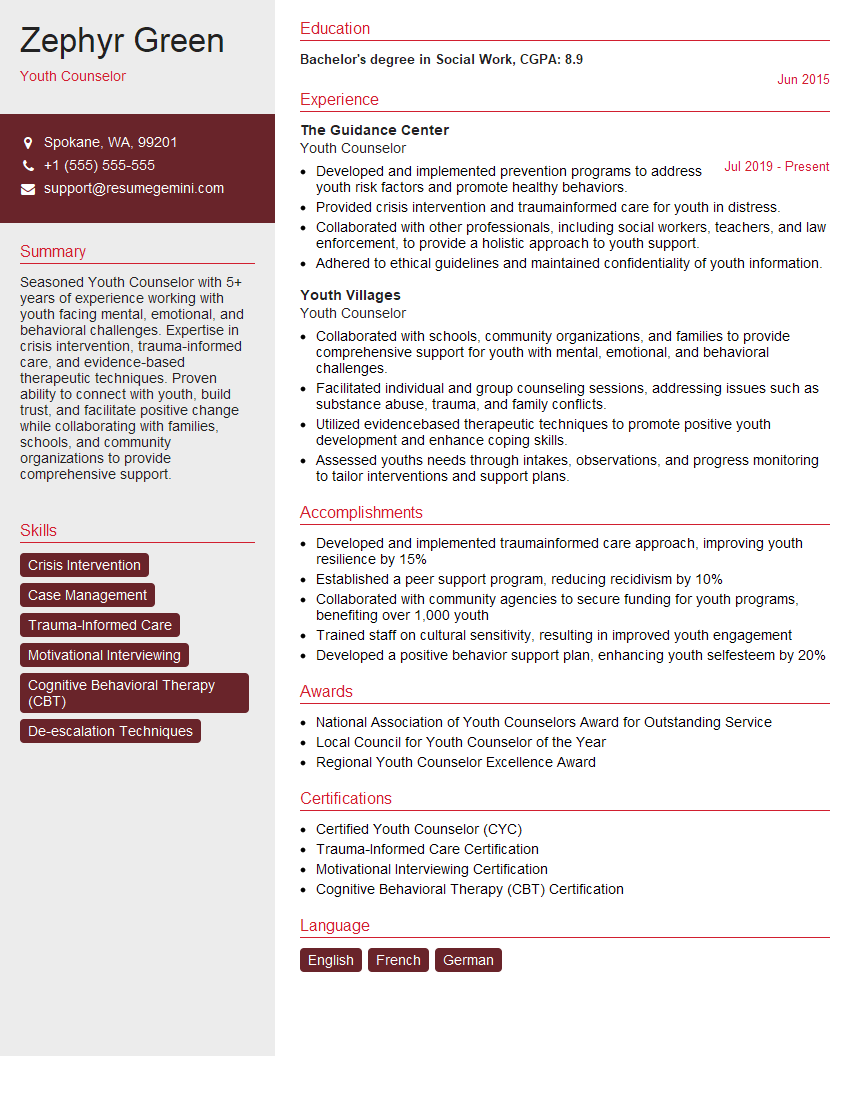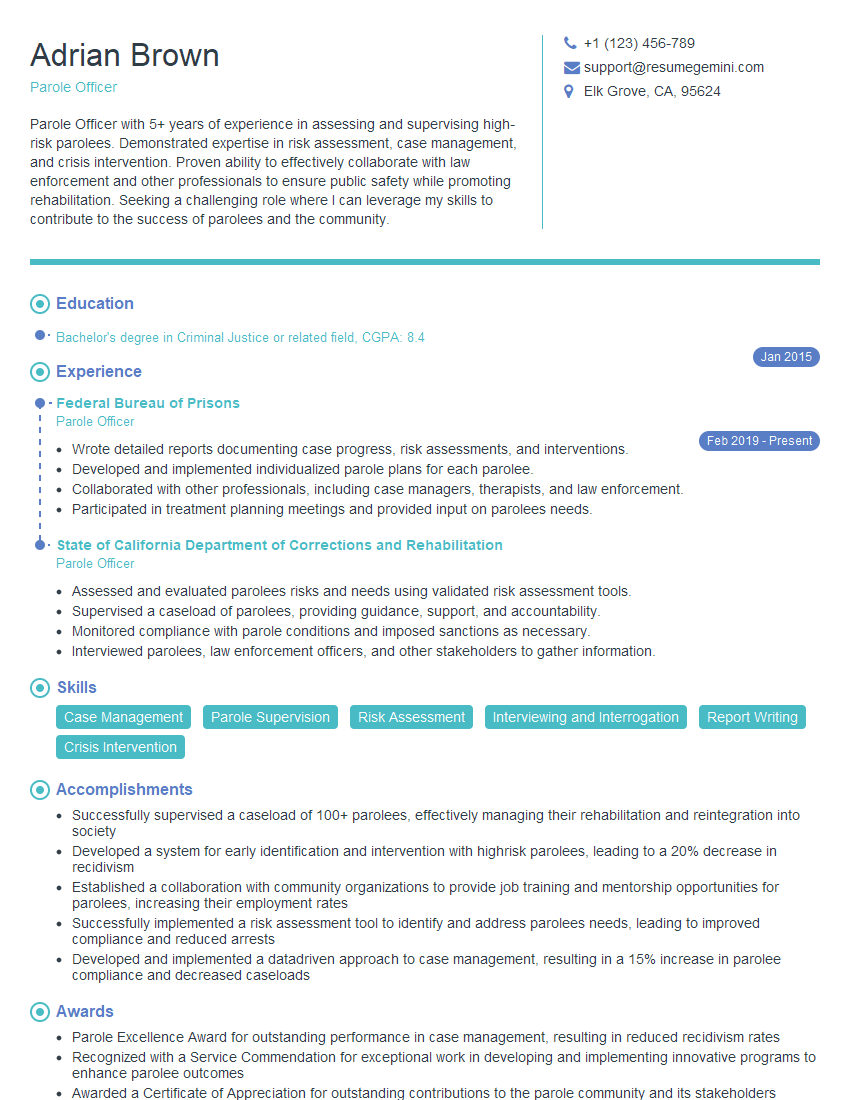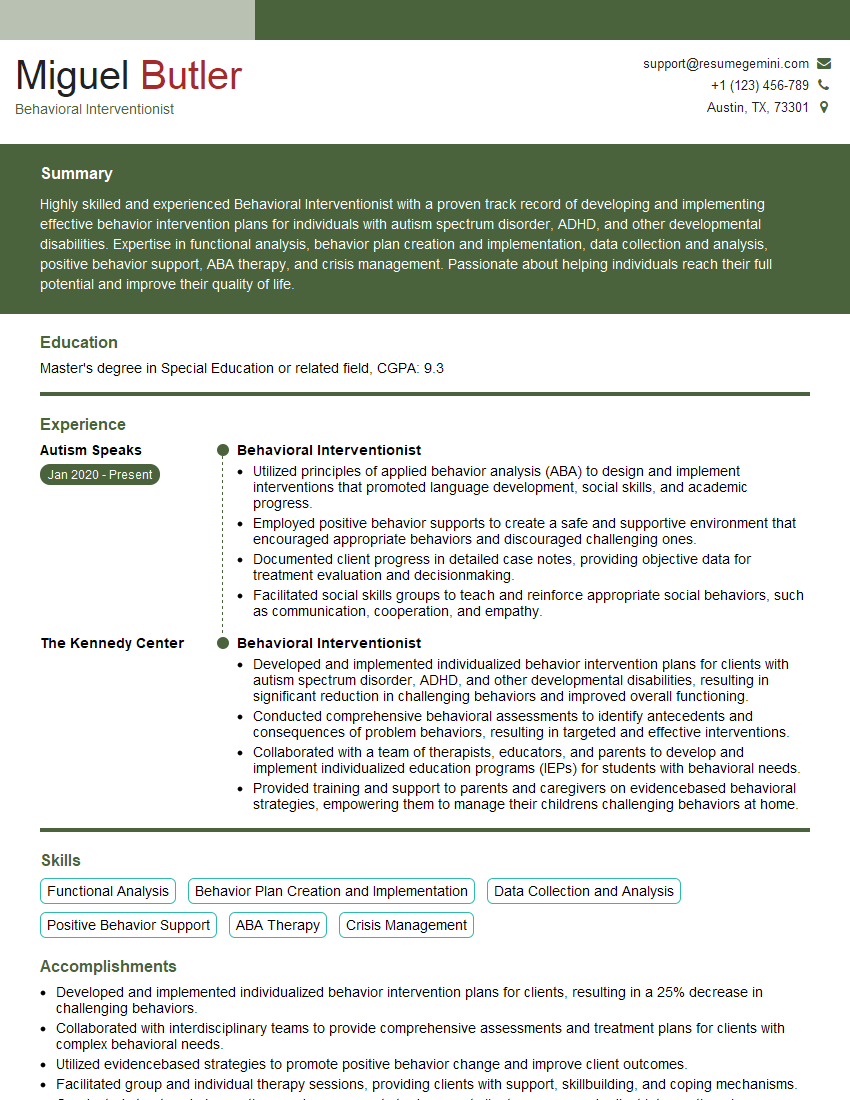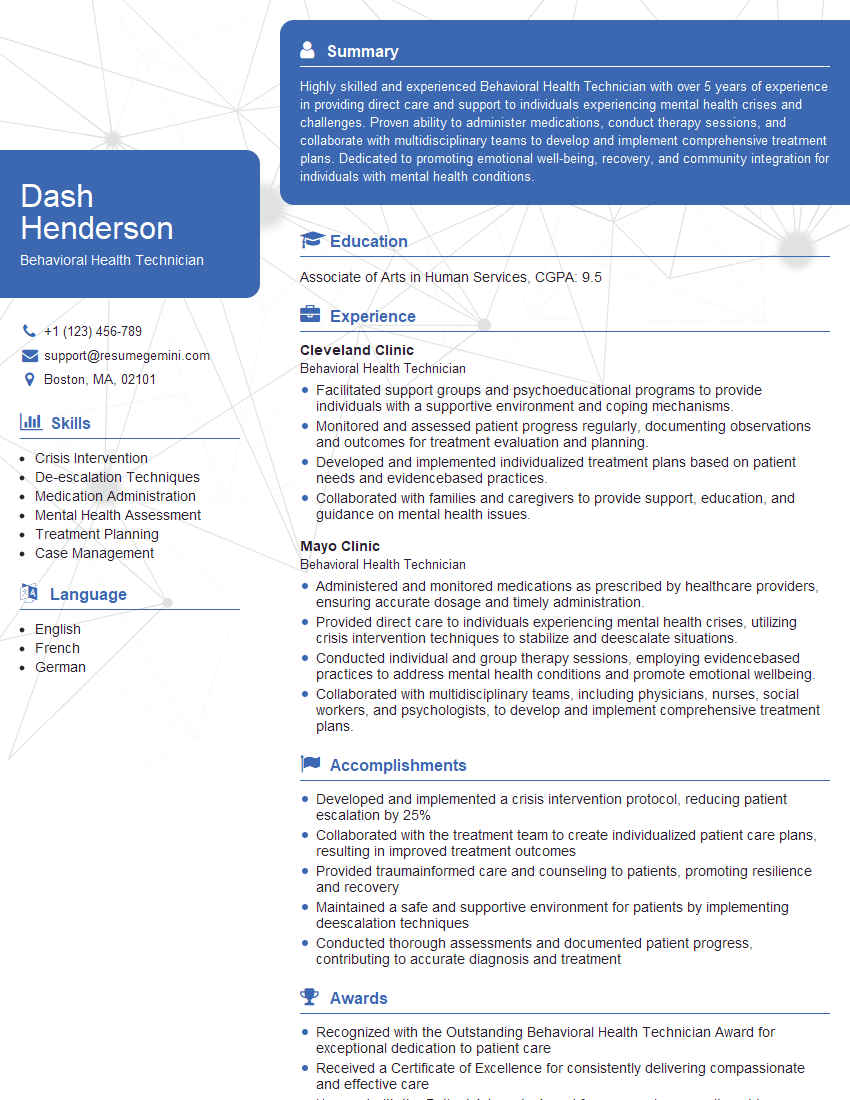Unlock your full potential by mastering the most common Managing Behavioral Challenges interview questions. This blog offers a deep dive into the critical topics, ensuring you’re not only prepared to answer but to excel. With these insights, you’ll approach your interview with clarity and confidence.
Questions Asked in Managing Behavioral Challenges Interview
Q 1. Describe your experience using positive reinforcement techniques.
Positive reinforcement is a cornerstone of my approach to managing behavioral challenges. It involves increasing the likelihood of a desired behavior by consistently rewarding it. I’ve extensively used this technique in various settings, from classrooms to individual therapy sessions. Instead of focusing on punishment, I concentrate on rewarding positive actions.
For example, in a classroom setting, I might implement a token economy system. Students earn tokens for exhibiting desired behaviors like active participation, completing assignments on time, or showing respect towards peers. These tokens can then be exchanged for privileges, such as extra recess time, choosing a classroom activity, or small prizes. This creates a positive association with the desired behaviors, making them more likely to be repeated.
Another example involves using praise and verbal affirmation. A simple “Great job focusing on your work!” or “I appreciate your effort in helping your classmate” can be incredibly effective in reinforcing positive behaviors. The key is consistency and immediacy – the reward should follow the desired behavior closely.
Q 2. Explain the difference between positive and negative reinforcement.
Positive and negative reinforcement are both methods used to increase the likelihood of a behavior, but they differ in their approach. Positive reinforcement adds something desirable to increase the behavior, while negative reinforcement removes something aversive to increase the behavior. It’s crucial to understand this difference because confusing the two can lead to unintended consequences.
Positive Reinforcement: Adding something positive to increase a behavior. Example: Giving a student a sticker for completing their homework (adding a sticker increases homework completion).
Negative Reinforcement: Removing something negative to increase a behavior. Example: A student finishes their chores to avoid their parents nagging them (removing the nagging increases chore completion). Note that this is different from punishment, which aims to decrease a behavior.
The distinction is subtle but critical. Negative reinforcement, while effective, shouldn’t be confused with punishment. Punishment involves adding something aversive (like a detention) or removing something positive (like screen time) to *decrease* a behavior.
Q 3. How do you address challenging behaviors in a classroom setting?
Addressing challenging behaviors in a classroom requires a multi-faceted approach that prioritizes prevention, proactive strategies, and individualized interventions. My approach begins with creating a positive and supportive classroom environment where students feel safe, respected, and engaged. This includes establishing clear expectations and rules, consistently reinforcing positive behaviors, and building strong teacher-student relationships.
When challenging behaviors arise, I focus on understanding the underlying cause. I might use observation, data collection, and conversations with the student to identify triggers and functions of the behavior. This is the foundation for creating a functional behavioral assessment (FBA), discussed later.
Strategies I employ include:
- Ignoring minor disruptions: Often, attention is the reinforcer for disruptive behaviors. Ignoring minor misbehaviors can effectively reduce their frequency.
- Proximity control: Simply moving closer to a student can often be enough to curb disruptive behavior.
- Positive redirection: Guiding a student toward a more appropriate behavior, such as offering an alternative activity.
- Verbal reprimands (delivered calmly and privately): Addressing inappropriate behaviors directly but in a non-punitive manner.
- Time-out (used strategically and with clear guidelines): A brief period of separation from the stimulating environment to allow the student to calm down.
Collaborating with parents and school support staff is also crucial for a consistent and effective approach.
Q 4. What are some common behavioral challenges you’ve encountered?
Throughout my career, I’ve encountered a wide range of behavioral challenges. Some of the most common include:
- Aggression: Physical or verbal attacks towards peers or adults.
- Defiance and non-compliance: Refusal to follow instructions or rules.
- Attention-seeking behaviors: Disruptive actions designed to gain attention.
- Withdrawal and avoidance: Lack of engagement and social interaction.
- Anxiety and emotional dysregulation: Difficulty managing emotions leading to outbursts or meltdowns.
- Learning difficulties: Frustration and disruptive behavior stemming from academic challenges.
The severity and frequency of these behaviors can vary greatly depending on individual factors such as age, developmental stage, and underlying conditions.
Q 5. How do you create a functional behavioral assessment (FBA)?
A Functional Behavioral Assessment (FBA) is a systematic process used to understand the function or purpose of a challenging behavior. It’s not about blaming the student but about identifying the triggers and consequences that maintain the behavior. This understanding is critical to developing effective interventions.
Creating an FBA involves the following steps:
- Identify the target behavior: Define the specific behavior to be addressed, using clear and observable terms. For example, instead of saying “acting out,” describe it as “hitting peers” or “verbally abusing classmates.”
- Gather data: Collect information on the behavior’s frequency, duration, intensity, and antecedents (what happens before the behavior) and consequences (what happens after the behavior). This can involve direct observation, interviews with the student, parents, and teachers, and review of school records.
- Analyze the data: Examine the collected information to identify patterns and relationships between the antecedents, behavior, and consequences. This helps determine the function of the behavior (e.g., to escape a task, gain attention, access to a preferred item).
- Develop a hypothesis: Based on the data analysis, formulate a hypothesis about why the student engages in the behavior. For example, the hypothesis might state: “The student hits peers to escape a difficult math assignment.”
- Develop an intervention plan: Based on the hypothesis, create a behavior intervention plan (BIP) that addresses the function of the behavior and teaches alternative, more appropriate behaviors.
The FBA is an iterative process; data should be continuously monitored and the hypothesis and intervention plan adjusted as needed.
Q 6. Describe your experience implementing behavior intervention plans (BIPs).
I have significant experience implementing Behavior Intervention Plans (BIPs). A BIP is a document that outlines specific strategies and interventions designed to address a student’s challenging behaviors. It’s developed based on the FBA and is crucial for providing a consistent and effective approach.
My experience includes developing BIPs for various challenging behaviors, such as aggression, self-injury, and defiance. The BIPs I’ve implemented often included:
- Antecedent strategies: Proactive measures to prevent the behavior from occurring, such as modifying the environment, providing clear instructions, and teaching self-regulation skills.
- Replacement behaviors: Teaching alternative behaviors that serve the same function as the challenging behavior. For example, teaching a student to ask for a break instead of hitting when frustrated.
- Consequence strategies: Responding to the behavior in a consistent and predictable manner. This might involve positive reinforcement for appropriate behaviors and logical consequences for challenging behaviors.
- Monitoring and data collection: Regularly tracking the student’s behavior to assess the effectiveness of the BIP and make necessary adjustments.
Successful BIP implementation relies on collaboration among parents, teachers, support staff, and the student themselves, fostering a cohesive and supportive approach.
Q 7. How do you adapt your approach to manage behavioral challenges based on individual needs?
Adapting my approach to individual needs is paramount. What works for one student might be ineffective or even harmful for another. I personalize my interventions by considering several factors:
- Student’s age and developmental level: Interventions need to be age-appropriate and developmentally sensitive. What works for a preschooler will differ significantly from what’s effective for a teenager.
- Underlying conditions: If a student has a diagnosed condition such as ADHD, autism spectrum disorder, or anxiety disorder, the intervention plan needs to address the specific challenges posed by these conditions.
- Cultural background: Cultural differences can significantly influence behavior and responses to interventions. It’s important to be culturally sensitive and respect the student’s cultural background.
- Individual preferences and learning styles: Interventions should be tailored to the student’s preferred learning style and personal preferences to maximize their effectiveness and engagement.
- Parent and family involvement: Close collaboration with parents is crucial for consistent implementation and generalization of interventions across different settings.
Regular monitoring and adjustments are essential. I frequently review data and adjust the approach based on the student’s response and progress. The process is fluid and responsive to the unique needs of each individual.
Q 8. How do you de-escalate a situation involving aggressive behavior?
De-escalating aggressive behavior requires a calm and controlled approach focused on safety and understanding the underlying cause. It’s crucial to prioritize the safety of everyone involved first.
My approach involves several key steps:
- Remain Calm: My own emotional state is paramount. I use deep breaths and controlled body language to project calm. Panic can escalate the situation.
- Create Space: Physically distancing myself (or the individual) helps reduce immediate triggers. If safe to do so, moving to a quieter environment can also be beneficial.
- Active Listening: I focus on understanding the individual’s perspective, validating their feelings even if I don’t agree with their actions. Phrases like, “I understand you’re feeling frustrated,” can be helpful.
- Clear Communication: I use simple, direct language, avoiding judgmental or accusatory tones. I clearly state expectations, like “It’s important to keep your hands to yourself.”
- Offer Choices: Presenting limited choices empowers the individual while maintaining control. For example, “Would you like to sit down for a few minutes, or would you prefer to take a walk?”
- Redirect: If appropriate, gently redirecting the individual’s attention to a different activity or focus can be effective. This might involve offering a preferred activity or a distraction.
- Seek Support: If the situation is beyond my capacity to manage, I immediately seek support from colleagues or supervisors. Safety is always the top priority.
Example: I once worked with a student who became aggressively frustrated during a classroom activity. I calmly removed him from the immediate situation, offering him a quiet space to cool down. I used active listening to understand his frustration with the task and collaboratively worked on finding alternative strategies to complete it.
Q 9. What strategies do you employ to promote self-regulation in individuals?
Promoting self-regulation involves teaching individuals to recognize, understand, and manage their emotions and behaviors. It’s a process, not a quick fix.
My strategies include:
- Teaching Self-Awareness: We work together to identify triggers and early warning signs of emotional escalation. This often involves using emotion charts or journals.
- Coping Skills Training: I teach specific coping mechanisms like deep breathing exercises, progressive muscle relaxation, and mindfulness techniques. These provide tools to manage intense emotions in the moment.
- Cognitive Restructuring: We explore and challenge negative thought patterns contributing to challenging behaviors. For instance, helping someone replace “I’m a failure” with “This task was challenging, but I can learn from it.”
- Positive Self-Talk: Encouraging positive self-statements and affirmations helps build self-esteem and resilience.
- Social Skills Training: Improving social skills equips individuals with tools to navigate social situations more effectively, reducing potential conflict.
- Sensory Regulation Strategies: For individuals with sensory sensitivities, implementing strategies to address sensory input (e.g., weighted blankets, quiet spaces) can improve self-regulation.
Example: I helped a child who struggled with impulsive outbursts by teaching them to recognize their increasing heart rate and sweaty palms as warning signs. We practiced deep breathing exercises to calm down before reacting impulsively.
Q 10. How do you collaborate with parents or guardians to manage behavioral challenges?
Collaboration with parents/guardians is essential for effective behavior management. It’s about creating a unified approach where home and school environments support each other.
My strategies for collaboration include:
- Regular Communication: Frequent updates (phone calls, emails, meetings) keep parents/guardians informed about progress and challenges.
- Shared Goal Setting: We collaboratively identify behavioral goals and develop strategies to achieve them. This ensures everyone is working towards the same outcome.
- Consistent Approaches: We strive for consistency in approaches used at home and school, minimizing conflicting messages for the individual. This might involve sharing behavior charts or strategies.
- Open Communication & Feedback: I encourage open dialogue, actively seeking feedback and adjusting strategies based on observations from both home and school.
- Parent Training: Where appropriate, I offer training or resources to equip parents/guardians with skills and knowledge to support behavior management at home.
- Positive Reinforcement Focus: We focus on celebrating successes and reinforcing positive behaviors, strengthening the parent-child bond.
Example: With one family, we implemented a points system rewarding positive behaviors at both home and school. Regular meetings ensured open communication about the child’s progress and adjustments to the system.
Q 11. Explain your understanding of Applied Behavior Analysis (ABA).
Applied Behavior Analysis (ABA) is a scientific framework used to understand and change behavior. It’s based on the principles of learning and focuses on observable behaviors. The core principles are:
- Antecedents: Events or stimuli that precede a behavior (e.g., a loud noise). Understanding antecedents helps identify triggers.
- Behavior: The observable action itself (e.g., crying, hitting).
- Consequences: Events that follow a behavior and affect the likelihood of it happening again (e.g., attention, removal of a task).
ABA uses these principles to identify functional relationships between behaviors, their antecedents, and consequences. By manipulating these elements, we can increase desired behaviors and decrease undesired ones. Interventions are data-driven, meaning we systematically collect data to track progress and modify strategies as needed.
Example: A child tantrums (behavior) when asked to clean their room (antecedent). If the tantrum results in the parent removing the cleaning task (consequence), the tantrum behavior is likely to continue. ABA would involve identifying alternative ways to deal with the antecedent (e.g., breaking the task into smaller steps, providing a visual schedule) and consequences (e.g., providing positive reinforcement for completing parts of the task).
Q 12. What is your experience with different types of reinforcement schedules?
Reinforcement schedules determine when and how often reinforcement is delivered following a desired behavior. Different schedules have different effects on behavior maintenance.
- Continuous Reinforcement: Reinforcement is delivered every time the desired behavior occurs. This is effective for initial learning but can be impractical long-term.
- Intermittent Reinforcement: Reinforcement is delivered only some of the times the behavior occurs. This is more resistant to extinction. There are several types:
- Fixed-Ratio: Reinforcement after a specific number of responses (e.g., rewarding every 5th correct answer).
- Variable-Ratio: Reinforcement after an average number of responses (e.g., slot machines). This schedule produces high rates of responding and is very resistant to extinction.
- Fixed-Interval: Reinforcement after a specific amount of time has passed, regardless of the number of responses. This often produces a scallop-shaped response pattern.
- Variable-Interval: Reinforcement after an average amount of time has passed. This produces a steady rate of responding.
Example: In a classroom setting, a fixed-ratio schedule might involve giving a student a sticker for every five correctly completed math problems. A variable-ratio schedule would mean sometimes giving a sticker after 3 problems, sometimes after 7, keeping the average around 5.
Q 13. How do you measure the effectiveness of your behavioral interventions?
Measuring the effectiveness of behavioral interventions relies on data-driven assessment. I utilize several methods:
- Frequency Counts: Tracking the number of times a behavior occurs within a specific time period.
- Duration Recording: Measuring how long a behavior lasts.
- Latency Recording: Measuring the time between a cue and the occurrence of a behavior.
- Interval Recording: Observing whether a behavior occurs during specific time intervals.
- ABC Data Collection: Recording the antecedent (what happened before), behavior, and consequence (what happened after) to identify patterns and functional relationships.
Data is graphed to visualize trends and determine whether interventions are effective. If progress plateaus or there’s no improvement, the intervention is reassessed and modifications are made.
Example: When implementing a new intervention for a student’s disruptive behaviors, I’d track the frequency of those behaviors daily, graphing the data to monitor change over time. If the frequency doesn’t decrease, I’d analyze the data to pinpoint areas for improvement in the intervention plan.
Q 14. Describe a time you had to modify a BIP due to ineffective results.
I once worked with a student whose BIP (Behavior Intervention Plan) focused on ignoring attention-seeking behaviors. While the plan had some initial success, the behaviors quickly returned and even intensified. Data analysis revealed that ignoring was actually reinforcing the behavior because the student was craving attention.
We realized that the initial plan was flawed because it didn’t address the underlying need for attention. We modified the BIP to include positive reinforcement for appropriate behaviors and teaching alternative ways to get attention. This involved a shift towards praising the student when they engaged in positive behaviors, using a token economy system, and teaching them appropriate ways to communicate their needs.
The modified BIP showed significant improvement. The frequency of attention-seeking behaviors decreased dramatically, and the student demonstrated increased prosocial behavior. This experience highlighted the importance of ongoing monitoring, data analysis, and flexibility in adapting interventions to meet individual needs and changing circumstances.
Q 15. What are some ethical considerations in managing behavioral challenges?
Ethical considerations in managing behavioral challenges are paramount. They center around respecting the individual’s rights and dignity while striving to improve their well-being. This involves several key aspects:
- Informed Consent: Ensuring the individual (or their legal guardian) understands the interventions being used and has given voluntary agreement. This extends to explaining potential risks and benefits clearly and honestly.
- Least Restrictive Interventions: Prioritizing the use of the least intrusive and restrictive methods possible. For example, before resorting to medication or physical restraints, we explore less restrictive strategies like positive reinforcement and environmental modifications.
- Confidentiality and Privacy: Protecting the individual’s personal information and ensuring that only authorized personnel have access to their records. This is crucial for building trust and maintaining a therapeutic relationship.
- Avoiding Bias and Discrimination: Recognizing and mitigating any personal biases that may influence our approach and ensuring that all individuals are treated with fairness and respect, regardless of their background or challenges.
- Cultural Sensitivity: Understanding and respecting the individual’s cultural background and beliefs when developing and implementing behavior support plans. What might be considered appropriate in one culture could be offensive or ineffective in another.
- Beneficence and Non-maleficence: Acting in the best interests of the individual, while also avoiding any actions that could cause them harm. This includes constantly evaluating interventions to ensure effectiveness and safety.
For example, I once worked with a young man whose cultural background valued family involvement heavily. We actively integrated his family into the intervention plan, which significantly improved treatment adherence and outcomes.
Career Expert Tips:
- Ace those interviews! Prepare effectively by reviewing the Top 50 Most Common Interview Questions on ResumeGemini.
- Navigate your job search with confidence! Explore a wide range of Career Tips on ResumeGemini. Learn about common challenges and recommendations to overcome them.
- Craft the perfect resume! Master the Art of Resume Writing with ResumeGemini’s guide. Showcase your unique qualifications and achievements effectively.
- Don’t miss out on holiday savings! Build your dream resume with ResumeGemini’s ATS optimized templates.
Q 16. How do you maintain confidentiality and client privacy?
Maintaining confidentiality and client privacy is fundamental to ethical practice. It involves several key strategies:
- HIPAA Compliance (or equivalent): Strict adherence to all relevant privacy laws and regulations, which dictates how protected health information (PHI) can be stored, accessed, and disclosed.
- Secure Record Keeping: Utilizing password-protected electronic systems and locked filing cabinets for physical records. Access should be limited to authorized personnel only.
- Data Anonymization: When sharing data for research or training purposes, ensuring that identifying information is removed or replaced with pseudonyms to protect individual anonymity.
- Informed Consent for Disclosure: Obtaining explicit consent from the client (or legal guardian) before sharing any information with other professionals or agencies, except in mandated reporting situations.
- Confidentiality Agreements: Ensuring all team members sign confidentiality agreements to emphasize the importance of protecting sensitive information.
Think of it like a bank vault—highly secure and accessible only to those with authorized access. I always ensure all our client data adheres to the strictest security protocols.
Q 17. How do you handle situations where you disagree with a parent’s approach to behavior management?
Disagreements with parents’ approaches to behavior management require careful navigation. The goal is to collaborate and find common ground, focusing on the child’s best interests.
- Active Listening: Start by actively listening to the parent’s perspective and understanding their reasoning. Often, they have valuable insights into their child’s behavior and home environment.
- Education and Collaboration: Present evidence-based strategies and research findings to support your recommendations. Frame your suggestions as collaborative options, rather than directives.
- Empathy and Respect: Acknowledge the parent’s emotions and challenges. Remember that they may be feeling overwhelmed, stressed, or frustrated.
- Compromise and Flexibility: Be willing to compromise and find solutions that incorporate aspects of both approaches. The goal is a unified strategy, not a power struggle.
- Referral: If disagreements are insurmountable or the parent’s approach puts the child at risk, consider referring the family to other resources, such as family therapy or parenting support programs.
For instance, I once had a disagreement with a parent about using punishment. We collaboratively developed a reward system that met the child’s needs and the parent felt more comfortable implementing.
Q 18. How do you prioritize safety when working with individuals exhibiting challenging behaviors?
Prioritizing safety is non-negotiable. This involves proactive strategies and careful risk assessment:
- Environmental Modifications: Altering the physical environment to minimize triggers and opportunities for challenging behaviors. This could involve removing potentially dangerous items, creating calming spaces, or improving supervision.
- Staff Training: Providing thorough training to staff on de-escalation techniques, crisis intervention, and physical restraint procedures (if necessary and legally permitted). Regular refresher training is crucial.
- Risk Assessment and Planning: Conducting regular risk assessments to identify potential dangers and developing individualized safety plans for individuals who exhibit challenging behaviors. These plans should detail specific procedures for managing various situations.
- Collaboration: Working closely with other professionals, including medical personnel, mental health specialists, and security personnel, to ensure a comprehensive approach to safety.
- Incident Reporting and Review: Implementing a robust system for reporting and analyzing incidents involving challenging behaviors to identify trends, patterns, and areas for improvement in safety procedures.
For instance, a detailed safety plan might specify which staff members are trained to use physical restraints, when it is appropriate, and the exact steps to follow, which we regularly review.
Q 19. What are some common triggers for challenging behaviors, and how do you address them?
Triggers for challenging behaviors are highly individual but often involve sensory sensitivities, unmet needs, or communication difficulties:
- Sensory Overload/Under-stimulation: Loud noises, bright lights, crowded spaces, or lack of stimulation can trigger meltdowns or aggression.
- Unmet Needs: Hunger, thirst, fatigue, or discomfort (pain) can lead to irritability and challenging behaviors.
- Communication Difficulties: Inability to express needs or frustration can manifest as disruptive behaviors.
- Changes in Routine: Unexpected changes to daily routines or familiar environments can be highly disruptive.
- Social Interactions: Conflicts with peers or authority figures can escalate into challenging behaviors.
Addressing triggers involves:
- Identifying and Avoiding: Through observation and data collection, identify specific triggers and strategies to minimize exposure.
- Sensory Regulation Techniques: Use strategies like weighted blankets, noise-canceling headphones, or calming activities to manage sensory input.
- Meeting Needs: Establish consistent routines, ensure adequate nutrition and rest, and promptly address any physical discomfort.
- Communication Supports: Implement picture exchange systems, sign language, or other assistive communication methods.
- Behavioral Interventions: Use positive reinforcement to encourage adaptive behaviors and functional communication training to teach alternative ways of expressing needs.
For example, one individual I worked with had difficulty with transitions. We developed a visual schedule to help him anticipate changes, thus reducing anxiety and challenging behaviors.
Q 20. Describe your experience with data collection and analysis in behavior management.
Data collection and analysis are critical for effective behavior management. This involves systematically tracking behavior occurrences to identify patterns, measure intervention effectiveness, and make informed decisions:
- Operational Definitions: Clearly defining the target behaviors to be measured. For example, instead of ‘aggression,’ specify the exact actions (hitting, kicking, yelling).
- Data Collection Methods: Using various methods, such as frequency counts, duration recording, interval recording, or event recording. Choosing the most appropriate method depends on the nature of the behavior.
- Data Recording Tools: Using data sheets, spreadsheets, or specialized software to track behavior occurrences. Accuracy and consistency are key.
- Data Analysis: Graphing the data to visually represent trends and patterns. This helps to evaluate the effectiveness of interventions.
- Functional Behavioral Assessment (FBA): Conducting a thorough FBA to determine the function (purpose) of challenging behaviors, providing information to guide intervention development.
For example, we might use a frequency count to track tantrums, recording how many tantrums occur per day. Graphing this data allows us to see if the frequency is increasing or decreasing after implementing an intervention.
Q 21. How do you ensure the accuracy and reliability of behavioral data?
Ensuring accuracy and reliability of behavioral data is paramount for effective intervention. This requires careful attention to detail and rigorous methods:
- Inter-rater Reliability: Having multiple observers independently record data to assess the consistency of observations. High inter-rater reliability indicates greater accuracy.
- Training Observers: Thoroughly training observers on the operational definitions of target behaviors and data collection procedures to minimize errors.
- Regular Calibration: Periodically reviewing data with observers to ensure consistency and address any discrepancies.
- Data Verification: Regularly reviewing recorded data to check for errors, omissions, or inconsistencies. Data should be checked and verified regularly.
- Appropriate Data Collection Tools: Using validated and reliable data collection tools. Using tools specifically designed for behavioral data is crucial.
For example, we might have two observers independently record instances of self-injurious behavior. We’d then calculate the inter-rater reliability to ensure their observations are consistent and reliable. Discrepancies would be discussed and addressed through further training and recalibration.
Q 22. What is your experience with crisis prevention and intervention training?
Crisis prevention and intervention (CPI) training is fundamental to my practice. It’s not just about reacting to crises; it’s about proactively preventing them. My training encompasses a range of techniques, focusing on de-escalation strategies, communication skills, and safe physical interventions (only as a last resort and always within legal and ethical guidelines). I’m proficient in recognizing early warning signs of escalation, such as increased anxiety, agitation, or changes in body language. This allows me to intervene early, using verbal de-escalation techniques like active listening, empathy, and offering choices to regain control. My CPI training includes regular refreshers to maintain my competency and ensure I’m up-to-date on best practices.
For example, I once worked with a client who became increasingly agitated during a group activity. By recognizing his nonverbal cues – clenched fists, rapid breathing – I was able to redirect him to a quieter space and engage him in a calming activity, preventing a full-blown crisis.
Q 23. Describe your understanding of different types of developmental disabilities and associated behavioral challenges.
Understanding developmental disabilities and their associated behavioral challenges is crucial. These disabilities impact an individual’s ability to learn, communicate, and interact socially. I’m familiar with a range of conditions, including Autism Spectrum Disorder (ASD), Intellectual Disabilities (ID), Down Syndrome, Cerebral Palsy, and others. Each condition presents unique behavioral challenges. For instance, individuals with ASD might exhibit repetitive behaviors, sensory sensitivities, and difficulties with social interaction. Those with ID might struggle with adaptive skills and exhibit behaviors related to frustration or communication limitations. Understanding the underlying causes of the behaviors—such as sensory overload, unmet needs, or communication difficulties—is key to developing effective interventions.
My approach emphasizes individualized support plans, which consider the specific needs and challenges of each individual. These plans incorporate strategies tailored to address their unique communication styles, sensory sensitivities, and behavioral patterns.
Q 24. How do you adapt your communication style to different individuals with varying communication abilities?
Adapting my communication style is essential. I believe communication is a two-way street. I avoid using jargon and instead use simple, clear language. I adjust my approach based on the individual’s communication abilities. This might involve using visual supports like pictures or objects, employing alternative communication methods such as sign language or assistive technology, or simplifying my language and using shorter sentences. For nonverbal individuals, I focus on nonverbal communication cues, such as body language and facial expressions.
For example, with a client who uses an augmentative and alternative communication (AAC) device, I ensure I’m familiar with the system and vocabulary. With a client who is primarily nonverbal, I might rely more on visual cues and gestures. The key is to be patient, observant, and responsive to their communication attempts.
Q 25. What is your experience with working within a multidisciplinary team?
Collaboration is key in managing behavioral challenges. I have extensive experience working within multidisciplinary teams comprising psychiatrists, psychologists, occupational therapists, speech therapists, educators, and family members. I understand the importance of open communication, shared decision-making, and integrated care. My role often involves facilitating communication between team members, ensuring everyone is on the same page regarding the client’s needs and treatment plan. I actively participate in team meetings, contributing my expertise in behavior management and providing regular updates on the client’s progress.
For example, in one case, I worked closely with a team to develop a behavior support plan for a client with ASD. This involved collaborating with the occupational therapist to address sensory sensitivities, the speech therapist to improve communication skills, and the parents to ensure consistency across settings.
Q 26. Describe a time you had to advocate for a client’s needs regarding behavioral issues.
I once had to advocate for a client who was repeatedly being excluded from group activities due to his challenging behaviors. The staff perceived his behaviors as disruptive, but I understood that his outbursts were stemming from unmet sensory needs and communication difficulties. I gathered data documenting the frequency, duration, and triggers of his behaviors. Then, I presented this data to the team, proposing alternative strategies such as providing sensory breaks, using visual schedules, and teaching him alternative communication methods. I also collaborated with his parents to ensure consistency in his support across all settings.
This advocacy resulted in a revised behavior support plan that focused on proactive interventions and teaching him more adaptive coping skills. The client’s participation in group activities increased significantly, and his challenging behaviors decreased.
Q 27. How do you maintain your own well-being while working with individuals exhibiting challenging behaviors?
Maintaining my well-being is paramount. Working with individuals who exhibit challenging behaviors can be emotionally and physically demanding. I prioritize self-care by utilizing strategies such as regular exercise, mindfulness practices, and maintaining a healthy work-life balance. I also engage in regular supervision sessions with a mentor to process challenging cases and receive support. I actively seek out opportunities for professional development to enhance my skills and stay updated on best practices. Open communication with my colleagues and supervisors is also vital, allowing me to discuss challenging situations and receive support from my team.
Recognizing my own limitations and seeking support when needed is crucial. I believe in building a strong support network and actively engaging in self-care to prevent burnout and maintain a healthy perspective.
Q 28. What are your professional development plans related to managing behavioral challenges?
My professional development plans focus on enhancing my expertise in managing behavioral challenges. I plan to pursue advanced training in applied behavior analysis (ABA) to further develop my skills in functional behavior assessments and evidence-based interventions. I also aim to expand my knowledge of trauma-informed care and its application in supporting individuals with challenging behaviors. Staying current with research and best practices through attending conferences, workshops, and participating in professional organizations is a continuous goal.
Continuous learning is essential in this field, and I’m committed to continually refining my skills to provide the best possible support to the individuals I work with.
Key Topics to Learn for Managing Behavioral Challenges Interview
- Understanding Different Behavioral Challenges: Learn to identify and categorize various behavioral challenges, considering developmental stages, individual needs, and environmental factors. This includes recognizing the nuances of different behavioral presentations.
- Functional Behavioral Assessment (FBA): Master the process of conducting FBAs to understand the function of challenging behaviors. Practice applying this knowledge to develop effective intervention strategies. Consider exploring different FBA models and their applications.
- Positive Behavior Support (PBS): Develop a strong understanding of PBS principles and its practical application. Learn how to create proactive and preventative strategies, focusing on teaching replacement behaviors and building positive relationships.
- Crisis Prevention and Intervention: Understand safe and effective techniques for de-escalation and crisis management. Familiarize yourself with best practices for responding to challenging situations while ensuring the safety of all involved.
- Collaboration and Communication: Learn effective strategies for collaborating with parents, guardians, educators, and other professionals involved in supporting individuals with behavioral challenges. Develop strong communication skills for conveying information clearly and empathetically.
- Data Collection and Analysis: Understand the importance of collecting and analyzing data to monitor the effectiveness of interventions and make data-driven decisions. Explore different data collection methods and their appropriate applications.
- Ethical Considerations: Review ethical considerations related to managing behavioral challenges, including respecting individual rights and dignity, maintaining confidentiality, and adhering to professional standards.
Next Steps
Mastering the art of Managing Behavioral Challenges significantly enhances your career prospects in education, social work, and related fields. It demonstrates a crucial skill set highly valued by employers. To stand out, creating a strong, ATS-friendly resume is essential. ResumeGemini can help you craft a professional resume that highlights your skills and experience effectively. We provide examples of resumes tailored specifically to Managing Behavioral Challenges to help you showcase your expertise. Take the next step in your career journey today.
Explore more articles
Users Rating of Our Blogs
Share Your Experience
We value your feedback! Please rate our content and share your thoughts (optional).
What Readers Say About Our Blog
Hi, I’m Jay, we have a few potential clients that are interested in your services, thought you might be a good fit. I’d love to talk about the details, when do you have time to talk?
Best,
Jay
Founder | CEO

